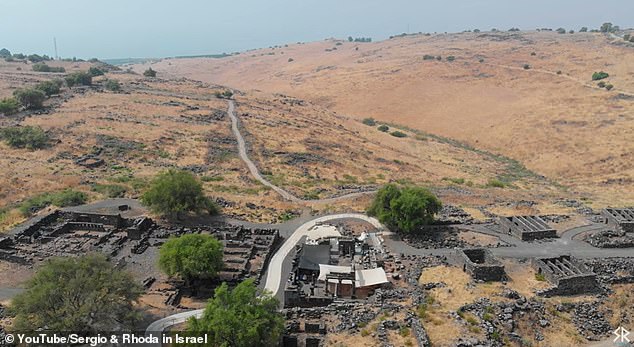Archaeologists make ‘groundbreaking’ discovery at Biblical site where Jesus is said to have performed miracles

Archaeologists may have discovered the existence of a long-lost temple where Jesus is said to have performed miracles.
Several passages in the New Testament describe him preaching and healing the sick in a synagogue in the ancient Israelite city of Chorazin.
Jews from around the world travel to a holy site in Korazim National Park in the north, where historical accounts say the Temple stood.
In the early 1900s, a synagogue dating from 380 AD was discovered, but there was no physical evidence that it dated back to the time of Jesus—until now.
During excavations at the synagogue discovered in 1905, a team of archaeologists discovered the ruins of an even older temple buried underneath.

Archaeologists excavating a synagogue dating back to 380 AD have discovered ruins of an earlier temple hidden beneath the floor. Experts have suggested that the path leading to the temple was walked by Jesus more than 2,000 years ago
‘This is a groundbreaking discovery. I’ve dug everywhere [the globe]“And for me it is definitely one of the most important excavations I have ever led,” said chief archaeologist Achia Cohen-Tavor of Dagesh Tourist Archaeology.
Cohen-Tavor and his team removed the floor of the third-century ruins and found giant boulders laid out in a specific way.
The team set to work removing the giant rocks and found pottery, coins and cooking utensils lying among the rocks.
“I can’t date the stone itself when it was put here,” Cohen-Tavor said in a YouTube video describing the discovery, which took place in 2022.
‘What I can date is the pottery and hopefully also the coins that come from between the rocks and certainly also what lies underneath.
‘What I can find between the stones provides information about the construction of the synagogue here.’
In the video he showed a collection of pottery that he determined dated back to the first century.
According to Cohen-Tavor, the giant boulders set into the ground and the artifacts provide the best evidence of first-century habitation ever found in the region.
The finds at the site are only clues about the first-century synagogue, but archaeologists are confident the artifacts will soon confirm their assumptions.
The Bible book of Matthew calls the place the city of Chorazin, where there was a synagogue where Jesus taught.
However, he also cursed the city after the locals rejected him and his teachings.
“Then he began to condemn the cities where most of his mighty deeds had been done, because they did not repent,” the holy book states.
‘Woe to you, Chorazin! Woe to you, Bethsaida! For if the mighty works that were done in you had been done in Tyre and Sidon, they would have repented long ago in sackcloth and ashes.’

They lifted the top floor and revealed giant boulders that were hundreds of years older

Pottery and coins were also found nestled among large rocks, allowing the team to date the site to the time of Christ.
It was said at that time that Tyre and Sidon were pagan cities.
The third-century synagogue was discovered in 1905 in what is now Korazim National Park.
Cohen-Tavor noted that previous excavations may have mistaken the giant boulders for simple rock, potentially overlooking the first-century ruins.
The building is built of basalt stones and decorated with Jewish motifs.
It had three entrances, the front of which faced south, toward Jerusalem, as was customary.
During previous excavations, a stone seat was also found, on which the Torah reader sat. This seat is also called the Chair of Moses.
Historical accounts from the early fourth century describe Chorazein as a pole two miles from Capernaum, which Jesus reportedly walked over.
And the path is still visible to this day.

The third-century synagogue was discovered in 1905 in what is now known as Korazim National Park. The structure was built of basalt stones and decorated with Jewish motifs

In addition to the synagogue, the Chair of Moses is also mentioned in the Bible
In addition to the long-vanished synagogue, the Chair of Moses is also mentioned in the Bible.
Matthew 23:1-2 reads: “Then Jesus spoke to the crowds and to his disciples, saying, 2 “The scribes and the Pharisees were sitting in Moses’ seat.”
It was a chair in which the rabbi and leaders read from the Torah scrolls, taught, and passed judgment.
All synagogues had such a place, and when Jesus taught in the synagogues of Galilee, he probably sat in the seat reserved for this authority.
A similar stone seat of Moses was found in an ancient synagogue on the island of Delos in Greece.
A chair of Moses was also found in Hammath Tiberias, near Tiberias on the Sea of Galilee.




